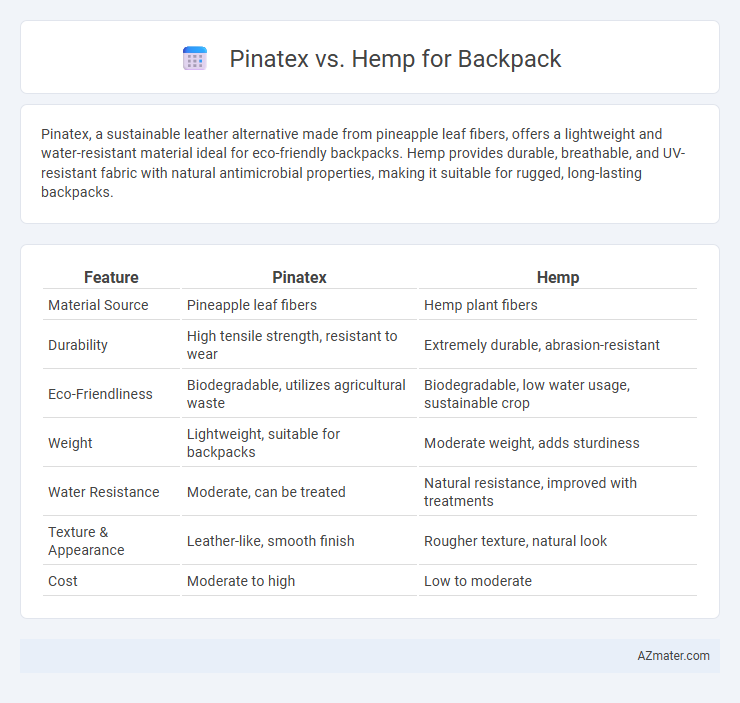Pinatex, a sustainable leather alternative made from pineapple leaf fibers, offers a lightweight and water-resistant material ideal for eco-friendly backpacks. Hemp provides durable, breathable, and UV-resistant fabric with natural antimicrobial properties, making it suitable for rugged, long-lasting backpacks.
Table of Comparison
| Feature | Pinatex | Hemp |
|---|---|---|
| Material Source | Pineapple leaf fibers | Hemp plant fibers |
| Durability | High tensile strength, resistant to wear | Extremely durable, abrasion-resistant |
| Eco-Friendliness | Biodegradable, utilizes agricultural waste | Biodegradable, low water usage, sustainable crop |
| Weight | Lightweight, suitable for backpacks | Moderate weight, adds sturdiness |
| Water Resistance | Moderate, can be treated | Natural resistance, improved with treatments |
| Texture & Appearance | Leather-like, smooth finish | Rougher texture, natural look |
| Cost | Moderate to high | Low to moderate |
Introduction to Sustainable Backpack Materials
Pinatex and hemp are innovative sustainable materials gaining popularity in eco-friendly backpack production. Pinatex, derived from pineapple leaf fibers, offers a leather-like texture with strong durability and minimal environmental impact. Hemp provides a highly renewable, biodegradable option with exceptional strength and resistance, making both materials excellent choices for sustainable backpacks.
What is Piñatex?
Pinatex is an innovative sustainable material made from pineapple leaf fibers, offering a cruelty-free alternative to leather. It features durability, breathability, and a unique texture that enhances backpack design while reducing environmental impact. Compared to hemp, Pinatex provides a softer finish and vibrant aesthetic, making it increasingly popular in eco-friendly fashion.
Understanding Hemp as a Material
Hemp stands out as a sustainable and durable material for backpacks due to its strong natural fibers, which offer excellent resistance to wear and tear. Compared to Pinatex, a leather alternative made from pineapple leaf fibers, hemp provides superior breathability and mold resistance, making it ideal for outdoor and travel gear. Its eco-friendly cultivation requires minimal water and pesticides, reinforcing hemp's reputation as a highly renewable and biodegradable textile choice.
Environmental Impact: Piñatex vs Hemp
Pinatex, made from pineapple leaf fibers, offers a sustainable alternative by utilizing agricultural waste, significantly reducing landfill contributions and water consumption compared to traditional leather production. Hemp, a fast-growing crop requiring minimal pesticides and water, excels in carbon sequestration and soil regeneration, enhancing its eco-friendly profile. Both materials present lower environmental impacts than conventional textiles, but hemp's cultivation benefits and biodegradability provide a stronger case for sustainable backpack manufacturing.
Durability and Strength Comparison
Pinatex, made from pineapple leaf fibers, offers a lightweight and water-resistant option but tends to be less durable under heavy stress compared to hemp. Hemp fibers are among the strongest natural fibers, providing exceptional tensile strength and abrasion resistance, making hemp backpacks highly durable for long-term use. For users prioritizing robustness and longevity, hemp is generally a superior choice, while Pinatex suits those seeking eco-friendly and stylish lightweight alternatives.
Water Resistance and Weather Performance
Pinatex offers moderate water resistance due to its pineapple leaf fiber composition, making it suitable for light rain but less effective in heavy downpours. Hemp, known for its natural durability and breathability, provides superior weather performance with enhanced water resistance when treated with wax or oils. For backpacks, hemp's robust structure and improved water repellence ensure better protection against harsh weather conditions compared to untreated Pinatex.
Comfort and Breathability Factors
Pinatex, made from pineapple leaf fibers, offers a soft and flexible texture that enhances comfort for backpacks, while its breathable structure allows efficient air circulation to reduce sweat accumulation. Hemp fabric stands out with its naturally coarse yet durable fibers, providing excellent moisture-wicking properties and superior breathability, making it ideal for extended wear. When comparing comfort and breathability, hemp generally surpasses Pinatex due to its stronger ventilation capabilities and ability to keep the interior dry during heavy use.
Aesthetic and Design Versatility
Pinatex offers a unique, natural texture derived from pineapple leaf fibers, lending backpacks an eco-friendly, rustic aesthetic with subtle variations that enhance visual appeal. Hemp provides a durable, coarse yet flexible fabric known for its earthy tones and ability to accept diverse dye patterns, making it highly versatile for various design styles. Both materials support sustainable fashion, but Pinatex excels in creating distinctive, lightweight backpacks while hemp stands out for rugged, long-lasting designs.
Cost-Effectiveness and Market Availability
Pinatex offers a cost-effective alternative to traditional leather with prices typically ranging from $15 to $25 per yard, making it accessible for sustainable backpack production. Hemp, while durable and eco-friendly, generally costs more--around $20 to $40 per yard--but benefits from increasing market availability due to rising demand in textile industries. Both materials are gaining traction, but Pinatex's competitive pricing and growing supplier network present a more budget-friendly option for large-scale backpack manufacturing.
Conclusion: Which Material is Best for Backpacks?
Pinatex offers a sustainable alternative to leather with its pineapple leaf fibers, providing a lightweight and water-resistant material ideal for eco-friendly backpacks. Hemp stands out for its exceptional durability, natural antimicrobial properties, and biodegradability, making it a robust choice for long-lasting, environmentally conscious use. Choosing between Pinatex and hemp depends on the priority of lightweight, innovative texture versus rugged strength and longevity in backpacks.

Infographic: Piñatex vs Hemp for Backpack
 azmater.com
azmater.com